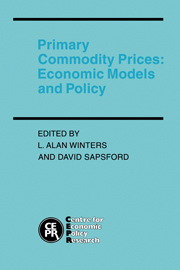1 - Primary commodity prices: an introduction to the major policy and modelling challenges
Published online by Cambridge University Press: 05 March 2012
Summary
Primary commodities constitute over 40 per cent of world trade and World Bank figures for 1986 reveal that of the 42 countries with a per capita GNP of less than $1,600, 20 were more than 70 per cent dependent on just two commodities for export earnings. As a result fluctuations in primary export earnings can disrupt LDCs' economic stability and interrupt the flow of finance for development. Primary commodities also play an important role in the behaviour of inflation in the industrial economies. Commodity price volatility has increased almost ninefold during the 1980s. The relationship between commodity prices and world economic activity appears to have broken down – prices were much more depressed than past experience would have suggested – and the relationship with the dollar appears to have shifted as well.
The experience of the 1980s provides an excellent opportunity to test and refine hypotheses about commodity price behaviour and to develop their implications for economic policy and the management of commodity markets. This book reports the proceedings of a major international conference on primary commodity price determination which was held in London during March 1989. The essays and discussants' comments illustrate both the current state of the art in commodity economics and the rich array of alternative approaches which exists. This introduction sets the analytical and policy scenes, places the contributions in their contexts and gives brief non-technical summaries of the principal results.
- Type
- Chapter
- Information
- Primary Commodity PricesEconomic Models and Policy, pp. 1 - 18Publisher: Cambridge University PressPrint publication year: 1990



